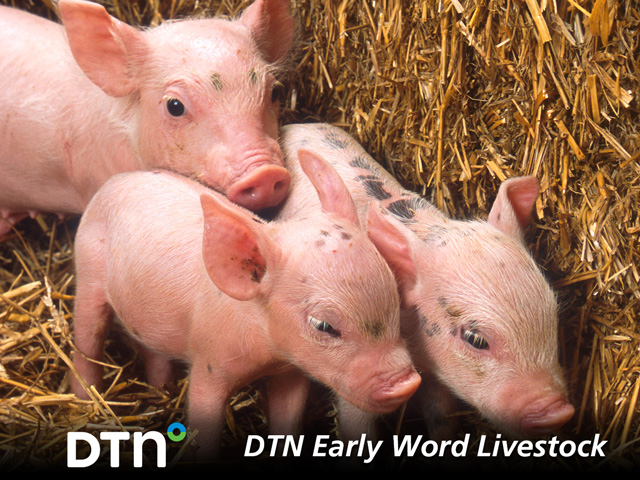DTN Early Word Livestock Comments
Firming Market Trend Developing
Cattle: Steady Futures: Higher Live Equiv $263.24 -13.42*
Hogs: Higher Futures: Mixed Lean Equiv $112.42 - 2.66**
* based on formula estimating live cattle equivalent of gross packer revenue
** based on formula estimating lean hog equivalent of gross packer revenue
General Comments:
Limited activity is expected early Tuesday in cash cattle trade as the cash market will be very interesting to watch through the week. Following a trend of higher price levels the last couple of weeks and increased packer buying due to improved processing levels, feeders are anticipating nothing less than steady money leading up to the Memorial Day holiday weekend. But with boxed beef tumbling lower on a daily basis, this could create enough momentum to curb cash spending increases in the next couple of weeks. The argument that the boxed beef market has been significantly out of line, and prices are falling back to a more reasonable and realistic level is actually bringing more underlying support back into the entire complex. Futures trade has also been sparked by strong outside market gains, with the Dow Jones Index posting a 900-point rally Monday. This overall support of widespread buyer support as traders look for potential growth over the upcoming weeks and months could spark renewed buyer interest Tuesday morning. So far, feeder cattle futures have lead this market recovery with moderate-to-strong buyer support developing in nearby feeder cattle futures as well as cash feeder cattle trade in many areas of the country. Tuesday slaughter is expected at 97,000 head.
Underlying support in late summer and fall contracts Monday afternoon helped to bring additional needed stability to the lean hog complex, which still remain generally weak due to the limited amount of hogs being processed compared to pre-COVID-19 levels. This continues to put price pressure on June and July futures trade and essentially eliminates any premium in summer contracts given that June through August contracts are trading within a 85-cent price spread. The focus through the lean hog complex will continue to be placed on daily slaughter numbers, although given the concern of overall growth in pork demand from the retail and food service industries, the lighter processing levels could likely still keep end supplies readily available. This does little to improve the overall concern of already backed up hog supplies and the supply glut seen well before the coronavirus started to impact plant production levels. Increased focus on outside market direction will continue through the rest of the week, although nearby and deferred contracts may continue to trade in different directions based on short-term fundamentals differing from the long-term direction of the market. Cash hog bids are expected $1 lower to 50 cents per cwt higher with most bids steady to weak. Slaughter Tuesday is expected at 391,000 head.
| BULL SIDE | BEAR SIDE | ||
| 1) | Last week's cash cattle trade ended with a average price of $112.31 per cwt. This is nearly $8 per cwt higher than the previous week, and approximately $15 per cwt above low prices set in April. This renewed support is helping to stimulate additional fundamental support through the complex. | 1) | Sharp losses continue to develop in boxed beef values. This is likely to create concerns that the recent gains in cash and futures values could erode at traders focus on the traditional relationship between cattle prices and beef values. |
| 2) | Active triple-digit gains in live cattle and feeder cattle futures have been driven by active buying moving into nearby and deferred feeder cattle futures. The added expectation that lower placements are likely in Friday's Cattle on Feed report should help to stimulate additional buyer activity. | 2) | The uncertainty of overall cattle supply levels following the slowdown of packing plants over the last month will create even more volatility going into Friday's Cattle on Feed report. This could limit additional concern through the complex as traders focus on overall cattle supplies leading into summer months. |
| 3) | Firm underlying gains in deferred lean hog futures during early week trade is pointing to more stable market supplies through the third and fourth quarter of the year with the expectation that packing plant production will resume to a more normal pattern in the coming weeks. | 3) | Nearby lean hog futures remain under light pressure as the limited packer capacity, even though larger than seen over the last couple of weeks, will limit the ability for hog supplies to become current anytime soon. |
| 4) | Further gains are seen in pork processing levels as day-by-day slaughter numbers continue to slowly grow. This is helping to limit concern of tight supplies of pork in retail and food service locations in the coming days and weeks.
| 4) | Sharp pork cutout losses continues to erode support in wholesale pork values, leaving concerns that these lower values will add to pressure through futures and cash hog trade. |
Rick Kment can be reached at rick.kment@dtn.com
(c) Copyright 2020 DTN, LLC. All rights reserved.
P[L1] D[0x0] M[300x250] OOP[F] ADUNIT[] T[]




